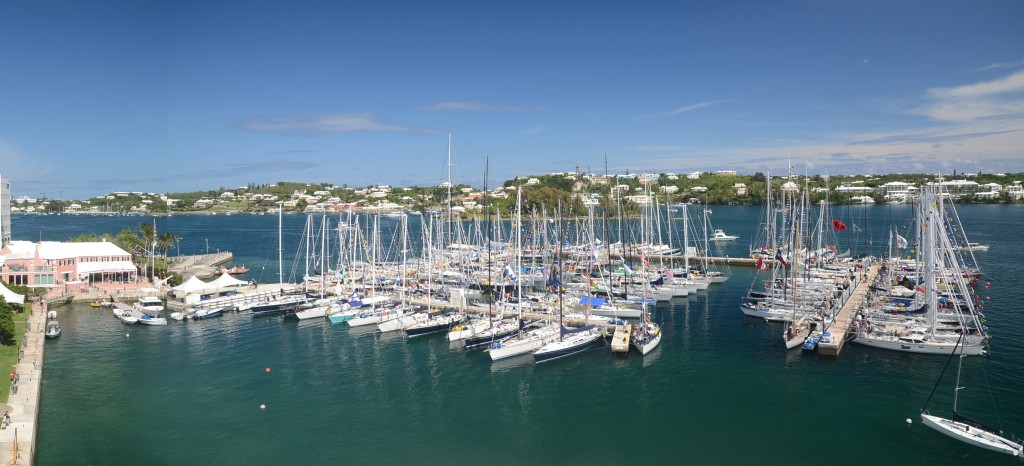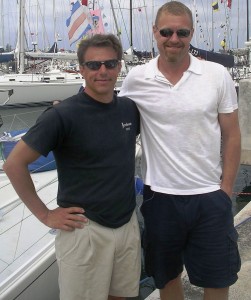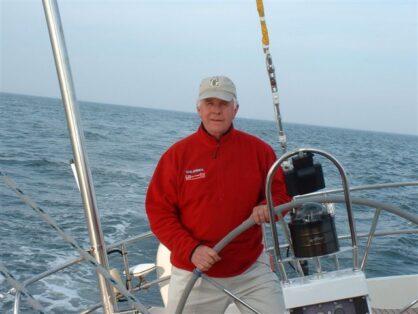
Here’s how a Bermuda Race veteran of long ago described his first steps when he staggered ashore after a Thrash to the Onion Patch: “We made tracks for the yacht club, and now, at last, with one foot on the rail of the Royal Bermuda Yacht Club bar, we might truly be said to have reached our goal.”
And so it was again this year. When the boats poured into Hamilton Harbour a day earlier than usual, the crews made tracks for the RBYC and its open-air bar where, over libations, they told their sea stories. There were plenty of tales of knockdowns and blown-out sails, but the story that topped them all concerned Kodiak’s encounter with a shark, which hung up first on the keel and then on the rudder before it broke in half.
Despite those and other edgy moments, this Bermuda Race fleet often felt enchanted. Everybody had thrilling stories of reaching at top speed for two days straight, often through fields of phosphorescence. “An out-of-body experience” is how Larry Glenn, skipper of the J-44 Runaway, described the voyage. “It was a very, very unusual race – in fast cool dry air, and it was a great ride. Can you imagine a J-44 finishing near Bolero’s record?” Yes indeed, Runaway’s time was just five hours shy of the 73-foot yawl’s 1956 elapsed time record of a little over 70 hours.
“That’s a lot,” said Larry, “and it was exhausting.”
The Right Things to Do
Amid the celebrations for this sensational sprint and for the great boat that won it (Carina has now equaled Finisterre’s record of three Lighthouse Trophies), the 2012 Newport Bermuda Race produced examples of responsible seamanship. On Sunday night, two race boats went to the aid of a competitor, Seabiscuit, one of whose sailors was suffering from complications of dehydration and needed to be evacuated. The fact that the sailor, Nate Owen, was picked up by a cruise ship doesn’t minimize the heroic efforts of the crews of Spirit of Bermuda and Flying Lady, or of his shipmate, Jonathan Green. Flying Lady’s owner, Phillip Dickey, explained his efforts very simply: “It was the right thing to do.” It’s also mandated by law, starting with Racing Rule 1.1 (“A boat or competitor shall give all possible help to any person or vessel in danger”) and including U.S. and international statutes.

The long night of concern for Owen ended with Owen in the cruise ship under professional medical care and the three yachts continuing the race. RBYC Commodore Jonathan Brewin called Green early Monday morning to express his concern about his state of mind after his harrowing experience. Green replied brightly, “I’m just fine. The boat’s making 9 knots!” He finished the race. Although she had a smaller crew than the one she started with, she was an official finisher because the International Jury decided, sensibly, that the loss was due to an injury.
Subsequently, the race organizers awarded citations for exemplary seamanship to Flying Lady, Seabiscuit, and Spirit of Bermuda, replica of a working three-masted schooner in the new Spirit of Tradition Division.
Another “right thing to do” contribution to safety must be mentioned. On the Sunday before the start, Tom Tobin, co-skipper of Inisharon, identified a conflict between Garmin chart plotters and AIS-triggered Kannad SafeLink crewoverboard alarms that caused the plotters to shut down. His assiduous work over the next two days resulted in Garmin’s sending three technicians to Newport to provide necessary software upgrades.
Woodies
Spirit of Bermuda was just one of four wooden boats in the race. Running into the crew of the 83-year-old, 52-foot yawl Dorade, I asked, “Was it a wet race?” The answer was this: “There was water everywhere! And those vents really work!”
“Those vents” are the air scoops rising from a box of baffles that Rod Stephens designed for his family’s boat in 1930. These ventilators revolutionized ocean sailing by letting the air into the cabin and keeping the water out, thereby making the boat habitable even when water’s flying around. The vents were immediately baptized with the name of the boat where they were first employed – and she was Dorade.
Two other woodies from the pre-World War III days of Sparkman & Stephens were in the race, Henry May’s New York 32 sloop Isla and Joe Robillard’s 68-foot yawl Black Watch. The best result by a wooden boat was Black Watch’s win in Class 6. This elegant classic was sailed with classic cunning by an experienced crew: “Our strategy was to go fast the first two days toward the island and see what we found when we got down there,” said Robillard. This strategy left them open-minded for the new conditions that swept in with the surprise pop-up low coming north from Bermuda. With her long waterline and yawl rig, Black Watch was optimized for reaching with five sails set – a good setup for this very unusual Bermuda Race.
Besides their appearance, the woodies had one very important thing in their favor: silence. The new carbon and fiberglass boats were like drums with waves beating on their decks and topsides. Alan Block reported from the hot Decision (top boat in the Onion Patch Series), “We’ve been averaging somewhere north of 13.5 knots for most of the trip, with a top speed just under 20, and it is loud, wet, difficult, and massively rewarding.”
For some of us, there are more rewards in quiet. The woodies may have been slower, but they’re blessed with natural fibre soundproofing. Said Black Watch’s navigator, Peter Rugg, “I’d forgotten how quiet a wooden boat is down below when you’re sailing in rough weather.”

May quiet reign over the Newport Bermuda Race until 2014.





























